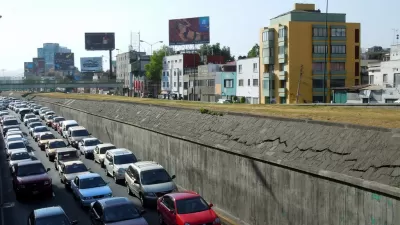A new RAND Corporation study models motorization growth rates and saturation levels, and identifies potential policies to encourage more efficient transportation in developing countries.

The report, The Future of Driving in Developing Countries by the RAND Corporation's Institute for Mobility Research, identifies various factors that affect motor vehicle ownership and use, including demographics (the portion of residents who work), incomes (which is the primary factor considered in previous studies), geography (density and travel distances), vehicle infrastructure (road and parking facility quality and price), fuel price, vehicle ownership policies (such as vehicle taxes and registration fees), quality of alternatives to driving, domestic oil and vehicle production industries political influence, and the favorability of car culture (whether popular culture and consumer attitudes favor automobile travel over other modes).
This analysis framework is used to develop a predictive model of motorization. The results indicate that although motor vehicle ownership and use tend to increase as incomes increase from very low to moderate, at high incomes they tend to saturate, and the level of saturation depends significantly on public policies. This explains why, for example, per capita vehicle travel saturated at about 4,000 annual kilometers in Japan, 7,000 annual kilometers in Germany, 10,000 annual kilometers in Australia, and 15,000 kilometers in the United States. This model can be used to predict future vehicle travel in developing countries, and to identify policies to help create more efficient and equitable transport systems.
FULL STORY: The Future of Driving in Developing Countries

Alabama: Trump Terminates Settlements for Black Communities Harmed By Raw Sewage
Trump deemed the landmark civil rights agreement “illegal DEI and environmental justice policy.”

Planetizen Federal Action Tracker
A weekly monitor of how Trump’s orders and actions are impacting planners and planning in America.

The 120 Year Old Tiny Home Villages That Sheltered San Francisco’s Earthquake Refugees
More than a century ago, San Francisco mobilized to house thousands of residents displaced by the 1906 earthquake. Could their strategy offer a model for the present?

In Both Crashes and Crime, Public Transportation is Far Safer than Driving
Contrary to popular assumptions, public transportation has far lower crash and crime rates than automobile travel. For safer communities, improve and encourage transit travel.

Report: Zoning Reforms Should Complement Nashville’s Ambitious Transit Plan
Without reform, restrictive zoning codes will limit the impact of the city’s planned transit expansion and could exclude some of the residents who depend on transit the most.

Judge Orders Release of Frozen IRA, IIJA Funding
The decision is a victory for environmental groups who charged that freezing funds for critical infrastructure and disaster response programs caused “real and irreparable harm” to communities.
Urban Design for Planners 1: Software Tools
This six-course series explores essential urban design concepts using open source software and equips planners with the tools they need to participate fully in the urban design process.
Planning for Universal Design
Learn the tools for implementing Universal Design in planning regulations.
Clanton & Associates, Inc.
Jessamine County Fiscal Court
Institute for Housing and Urban Development Studies (IHS)
City of Grandview
Harvard GSD Executive Education
Toledo-Lucas County Plan Commissions
Salt Lake City
NYU Wagner Graduate School of Public Service





























